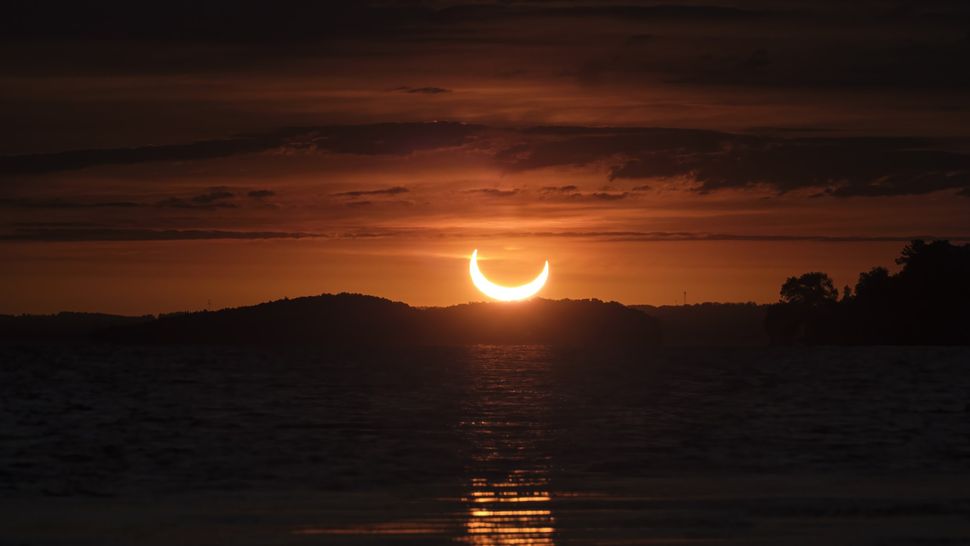Have you ever seen the sun rise twice in one morning? On March 29, 2025, parts of the US and Canada will witness the rare and awe-inspiring double sunrise solar eclipse 2025 — a celestial spectacle you don’t want to miss.
As the moon partially eclipses the sun right at sunrise, certain locations along the northeast coastline will experience a visual illusion that makes it look like two suns are rising, creating a “double sunrise” effect. This unique astronomical event will be visible to those in the right place at the right time — with a clear ocean horizon and good weather.
Let’s explore what causes this effect, the best locations to view it, how to prepare safely, and what tools you’ll need for the perfect skywatching experience.
🌅 What Is the Double Sunrise Solar Eclipse 2025?
The double sunrise solar eclipse 2025 is a partial solar eclipse happening at sunrise for parts of North America, including the U.S. state of Maine and Canada’s New Brunswick and Quebec provinces. During this event, the moon will cover up to 80–90% of the sun as it rises — and from certain vantage points, it will appear as if two suns are rising: the sun’s crescent peaks emerging like devil’s horns.
This rare alignment offers a once-in-a-lifetime visual, combining the rising sun’s brilliance with the mysterious silhouette of the moon.
🗺️ Understanding the Eclipse Map
NASA’s interactive eclipse map shows a wide shadow path stretching from northeastern North America to Europe and parts of Africa.
-
The orange lines indicate where the eclipse will end or begin at sunrise.
-
The blue line across northern Maine, southwestern New Brunswick, and southern Quebec marks where the eclipse peaks exactly at sunrise—the ideal place to view the double sunrise.
📍 Best Places to Watch the Double Sunrise Solar Eclipse 2025
To catch the best views of the double sunrise solar eclipse 2025, you’ll need a clear eastern horizon—preferably facing the ocean. Here are top viewing locations:
🇺🇸 United States (Maine)
-
Lubec, ME – One of the first towns to see the sunrise in the US
-
Bar Harbor, ME – Coastal cliffs offer dramatic viewing
-
Acadia National Park – Great for photography and viewing
🇨🇦 Canada
-
Saint John, New Brunswick – Good coastal visibility
-
Gaspé Peninsula, Quebec – Offers a clear line of sight to the east
-
Magdalen Islands – Remote and ideal for an unobstructed ocean view
Note: From cities like New York (21%) and Boston (43%), partial views will still be visible, though without the full “double sunrise” illusion.
🛠️ How to Prepare and What to Bring
To fully enjoy the double sunrise solar eclipse 2025, plan ahead:
-
✅ Check local weather forecasts the day before.
-
✅ Use tools like Xavier Jubier’s Eclipse Map and The Photographer’s Ephemeris to verify your view.
-
✅ Bring solar eclipse glasses — never look at the sun without proper protection.
-
✅ Have solar filters if using binoculars or telescopes.
-
✅ Use a tripod-mounted camera with solar filters for safe photography.
🧠 Why This Eclipse Is So Unique
-
✓ The eclipse coincides with sunrise, creating surreal visuals
-
✓ Locations near the maximum path will see “horns” of the sun rise first
-
✓ This is not a total eclipse, but the timing and angle make it incredibly special
❓FAQs: Double Sunrise Solar Eclipse 2025
Q: What time does the double sunrise solar eclipse 2025 start?
A: The eclipse begins at sunrise on March 29, 2025, with exact times depending on your location.
Q: Can I see it from New York or Boston?
A: Yes, though the eclipse will only cover 21% in New York and 43% in Boston, and you may not see the full double sunrise effect.
Q: Is it safe to look at the eclipse with sunglasses?
A: No. You must use certified eclipse glasses or solar filters for safe viewing.
Q: What causes the “double sunrise” effect?
A: It’s an optical illusion where the sun’s eclipsed crescent cusps rise separately, appearing as two suns.
Q: Will this happen again soon?
A: This type of double sunrise eclipse is rare. The next similar event may not happen for decades.
📝 Final Thoughts: Don’t Miss the Double Sunrise Solar Eclipse 2025
If you’ve never witnessed a celestial event quite like this, March 29, 2025, is your chance. With the right location and clear skies, you could experience a sunrise unlike any other — where the sun rises twice, thanks to the perfect alignment of the moon and Earth.
Will you be chasing this once-in-a-lifetime skywatching moment?
Read our previous article: Mental health camps help children cope with trauma of war


